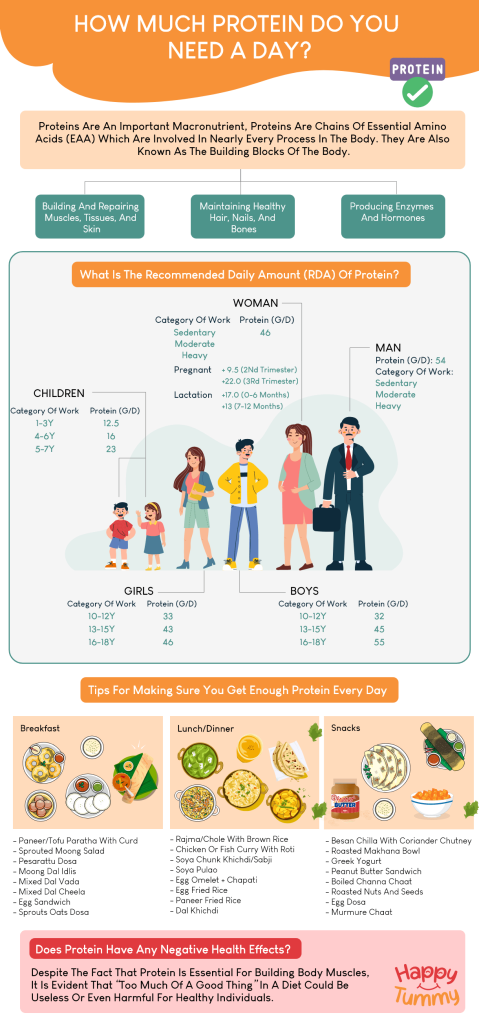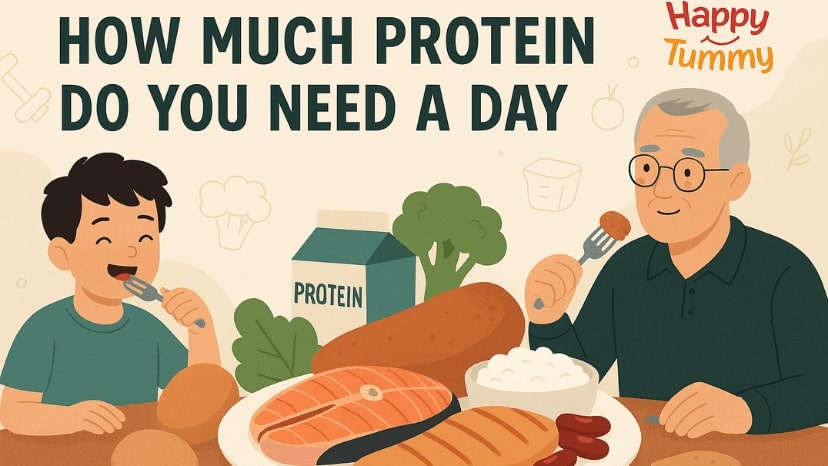Table of Contents
Protein is often the center of the world of nutrition, and for good reason. From gym-goers to adults, adolescents, athletes, pregnant women, lactating women, etc., everyone seems to be asking, “Am I getting enough protein?”
Well, how much protein do you need? Is more always better?
What exactly do grams of protein mean on the label of your favorite snack?
Let us learn about it all.

What is Protein, and why is it Important?
Proteins are an important macronutrient. Proteins are chains of essential amino acids (EAA) that are involved in nearly every process in the body. They are also known as the building blocks of the body.
They are biopolymeric structures composed of amino acids that provide structural support to the body, required to function properly. [1] Proteins are crucial for:
- Building and repairing muscles, tissues, and skin
- Maintaining healthy hair, nails, and bones
- Producing enzymes and hormones
When protein is not enough in the body, it may struggle to perform the critical tasks that may lead to fatigue, muscle loss, and a weak immune system.
Different sources of protein have different amino acid compositions.
Proteins from various foods have varied amino acid profiles. While plant-based diets tend to be deficient in some amino acids, many lean meats and dairy products happen to include all of them.
In spite of this, it is entirely feasible to obtain sufficient amounts of all the necessary protein components on a plant-based diet with just a little bit of investigation and nutritional thought. To meet protein goals, you may also use homemade supplements like sattu powder and more.
Inadequate intake may lead to loss of energy, fatigue, malnutrition, muscle weakness, improper functioning of the immune system, etc.
What do grams of protein really mean?
It refers to the number of grams of the macronutrient protein and not the grams of protein-containing food like meat or eggs.
For example, 1 bowl of moong dal might weigh 250 g, which may contain approximately 8-11g of protein.
What Is the Recommended Daily Amount (RDA) of Protein?
Research conducted by an expert group (ICMR-NIN 2020), adopted by FAO/WHO/UNU (2007), provides approaches to understand the protein requirement for Indians of different age groups. [2]
According to it, the recommended RDA for protein intake should ideally be considered as 0.8-1g per kg body weight per day for adults. Additionally, this means that a person can take 0.83 grams of protein per kilogram of their body per day.
For example, for a person weighing 50kg, the RDA of protein is 0.83 * 50 = 41.5 grams of protein per day. [2]
Here is the summary of recommended protein requirements for Indians:
According to the ICMR-NIN 2020 RDA, the protein requirements are-
| Age | Category of Work | Protein (g/d) |
| Man | Sedentary | 54 |
| Moderate | ||
| Heavy | ||
| Woman | Sedentary | 46 |
| Moderate | ||
| Heavy | ||
| Pregnant | + 9.5 (2nd trimester)+22.0 (3rd trimester) | |
| Lactation | +17.0 (0-6 months)+13 (7-12 months) | |
| Children | 1-3y | 12.5 |
| 4-6y | 16 | |
| 5-7y | 23 | |
| Boys | 10-12y | 32 |
| 13-15y | 45 | |
| 16-18y | 55 | |
| Girls | 10-12y | 33 |
| 13-15y | 43 | |
| 16-18y | 46 |
Varying Protein Requirements
Certain factors might change the RDA of protein intake necessary to support healthy aging.
The protein requirement is different for every age group and also differs based on gender, body weight, and physiological conditions such as pregnancy, lactation, and physical activity levels.
Age Group
According to the RDA, the protein requirement varies for every age group, including children, adolescents, adults, etc. Protein is an important macronutrient that is needed for growth & development.
The RDA(recommended dietary allowance) has specifically mentioned the protein requirements for every age group.
In children & adolescents,s protein is essential for physical growth, physiological functioning, brain development, cognitive development, etc.
In adults, although there is not much growth, Protein intake is important to repair and replace worn-out hardworking tissues, necessary for maintaining muscle mass, etc
During pregnancy and lactation, there is an increased demand of protein for the growth and development of the fetus and infant, as well as the well-being of the mother.
The study suggests that a more even distribution of protein throughout the day, with protein intakes at each meal falling within the range of age-related muscle mass, may make it easier to keep muscle mass over the long run. [10]
Weight Loss
Protein plays an important role in regulating body weight and fat loss by increasing the levels of satiety hormones. Because of this, people tend to eat fewer calories naturally.
Protein-rich meals can reduce late-night snack cravings. When protein intake is combined with regular exercise, it can improve overall body composition, resulting in more muscle, less fat, and a toned body.
Read more: The Many Benefits of Effective Weight Management.
Level of activities in the day
As per physical activity level, protein requirements may vary. The protein needs of an athlete or a weight trainer, high-intensity workout, etc, may differ from an individual with a sedentary lifestyle.
The recent Recommended Dietary Allowance (RDA) of protein is 0.8-1g/kg of body weight per day for healthy individuals. However, it has become clear that active individuals trying to maximise training adaptation would benefit from a daily intake of at least 1.2-1.5 g/kg.
Besides that, protein may help you feel full in a good way. People who work out a lot may run long distances or lift weights for long periods of time, which may drain their energy. Giving your body more protein may help it recover and keep you from getting hungry.
Muscle Mass of the body
The body uses protein to repair and rebuild body tissues that naturally break down from day-to-day activities such as exercise. Without adequate protein, the body cannot repair itself, leading to the loss of muscle mass over time.
Consuming sufficient protein can slow this process, preserving lean mass and supporting metabolic health.
Maintaining adequate muscle mass is essential not just for looks or strength but for:
- Posture and joint stability
- Daily movements (like climbing stairs or lifting objects)
- Preventing falls and fractures in older adults
Best Practices
- Spread protein intake across the day (20–30g per meal)
- Combine resistance training with a protein-rich diet
- Include high-quality protein (complete with all essential amino acids) when possible
Protein during pregnancy & lactation
When a woman is pregnant or nursing, her body needs more protein to help the developing baby and the uterus grow. After giving birth, a good supply of protein is always needed for milk production.
According to ICMR-NIN, an additional 9g/day (2nd trimester) and 22g/day (3rd trimester) is recommended. During lactation, up to 16g/day extra may be needed in the first 6 months.
Adequate protein intake is essential for both maternal health and infant development.
Tips for Making Sure You Get Enough Protein Every Day
Getting enough protein in your diet doesn’t have to be complicated—even if you are a vegetarian, vegan, or non-vegetarian, or, let’s say, on a tight budget.
Get your protein from plants when possible. Eating legumes (beans and peas), nuts, seeds, whole grains, and other plant-based sources of protein is a win for your health.
Here are some examples for each category:
- Legumes: lentils, beans (chickpeas, kidney, mung, pinto, etc.), peas (green, split, etc.), soybeans (and products made from soy: tofu, tempeh, etc.), peanuts.
- Nuts and Seeds: almonds, pistachios, cashews, walnuts, hazelnuts, pecans, hemp seeds, squash and pumpkin seeds, sunflower seeds, flax seeds, sesame seeds, chia seeds.
- Whole Grains: wheat, quinoa, rice, wild rice, millet, oats, buckwheat,
- Other: While many vegetables and fruits contain some level of protein, it’s generally in smaller amounts than the other plant-based foods. Some examples with higher protein quantities include corn, broccoli, asparagus, Brussels sprouts, artichokes, avocado, figs, dried dates, and dried raisins.
The key to enough non-vegetarian sources of protein-
- Poultry (chicken, Eggs, quail, duck)
- Seafood (fish, crabs, prawns).
- Dairy foods (yogurt, curd, milk, cheese, Paneer).
- Red meat (mutton, lamb)
The protein is a planned, balanced meal plan. Our certified nutritionists are capable of providing personalized, extensive meals upon taking the “My Meal Plan” test to check how much fibre and other proteins you are getting in your everyday meals.
You may aim to have a protein source in each major meal and at least one snack. Here are a few high-protein options:
Breakfast:
- Paneer/tofu paratha with curd[5]
- Boiled eggs or omelette with whole grain toast[6]
- Peanut butter on multigrain bread + milk[7]
- Sprouted moong salad
- Pesarattu Dosa
- Moong dal idlis
- Mixed dal vada
- Mixed dal cheela
- Egg sandwich
- Sprouts Oats Dosa
Lunch/Dinner:
- Rajma/Chole with brown rice[3] [4]
- Chicken or fish curry with roti
- Tofu or paneer stir-fry with quinoa
- Dal + vegetable sabzi + roti combo [8]
- Soya chunk khichdi/sabji
- Soya pulao
- Egg omelet + chapati
- Egg fried rice
- Paneer fried rice
- Dal khichdi
Snack Options:
- Besan Chilla with coriander chutney (Aashirvaad Besan goes well with all of your delicious foods. Made from the best 100% Bikaneri chana dal, this besan promises batter that is smooth and free of lumps and tastes better than anything else on the market.)
- Roasted Makhana Bowl
- Protein smoothie with milk/yogurt, nuts, and seeds
- Greek yogurt
- Peanut salad
- Peanut butter sandwich
- Boiled channa chaat
- Roasted nuts and seeds
- Egg dosa
- Murmure chaat
Also read—Top protein-rich foods for Indians
Disclaimer: Individual protein requirements can vary based on health conditions, physical activity, and medical history. Always consult a qualified healthcare provider or a registered dietitian before making significant changes to your diet.
Does Protein Have Any Negative Health Effects?
A study conducted on subjects consuming diets containing high amounts of protein daily showed doubled urinary calcium, while the calcium balance became negative. [9]
Despite the fact that protein is essential for building body muscles, it is evident that “too much of a good thing” in a diet could be useless or even harmful for healthy individuals.
For the sake of short-term gains, many adults and even teenagers who compete in bodybuilding self-prescribe protein supplements, ignoring the potential side effects. People may be at risk because this puts metabolic stress on vital organs like the heart, liver, kidneys, and bones. [9]
Our certified nutritionist can offer individualized nutrition guidance if you’re seeking strategies to increase your protein intake. To schedule a consultation, click the link!
Some Important Tips
- Protein timing matters—distribute protein intake evenly throughout the day for better muscle synthesis.
- Too little content: Deficiency of protein content in the body may lead to hair loss, fatigue, poor wound healing, decreased immunity, & PEM(protein energy malnutrition), and even muscle wasting.
- Weight management: A high-protein diet may help in maintaining satiety & appetite and increasing metabolism if taken under a nutritionist’s guidance. It may even preserve lean muscle mass during calorie restriction.
- Quality over quantity: Focus on natural sources of protein that are nutrient-rich and sustainable.
Bottom Line
Protein is essential for the good health of the body. If taken in the right amounts, it may help in building muscle mass, enzyme and hormone production, immune function, weight management, building strength, and improving overall cellular functions.
The RDA for protein for an adult Indian is 0.8-1g/ kg body weight. But this will be different for each person based on their sex, age, health, physical activity level & physiological conditions.
You can include eggs, chicken, fish, milk, and curd to get enough protein in your daily diet. Some of the plant sources include dals, legumes, tofu, chilla, seeds, whole grains, and soy. You can choose roasted chana and Greek yogurt for a happy tummy.
You must use Aashirvaad Besan to make Besan Chilla; it goes well with all of your delicious foods. Made from the best 100% Bikaneri chana dal, this besan promises batter that is smooth and free of lumps and tastes better than anything else on the market.
Excessive protein can be harmful as it might lead to digestive issues, dehydration, displacement of nutrients, strain on the kidneys, and more. Hence, always consult a doctor before making dietary changes to your body.
FAQs
The RDA for protein requirement is 54g/d for men & 46g/d for women.
For a 70kg person, 0.8*70 = 56g of protein is recommended.
Gaining muscle mass, toning of muscles, and body shaping requires a specific exercise regimen followed by appropriate dietary changes, especially in terms of good quality proteins balanced with appropriate calories, which should be done under professional guidance.
The daily protein requirement should ideally be followed as 0.8-1g per kg body weight.
However, excess consumption of protein in the daily diet can cause various side effects and health-related issues. For guidance on higher protein requirements for specific health or fitness needs, please contact a healthcare professional or a registered dietitian.
For a typical Indian adult who does not do much, the RDA to avoid a deficit is 0.8-1g per kilogram of body weight.
Some foods that are high in protein are lean meats, birds like chicken and turkey, fish, seafood, eggs, dairy products like Greek yogurt and cottage cheese, and plant-based foods like tofu, lentils, beans, and legumes. Here are some of the sources of protein that can be included in your daily diet:
–Legumes: lentils, beans (chickpeas, kidney, mung, pinto, etc.), peas (green, split, etc.), soybeans (and products made from soy: tofu, tempeh, etc.), peanuts.
–Nuts and Seeds: almonds, pistachios, cashews, walnuts, hazelnuts, pecans, hemp seeds, squash and pumpkin seeds, sunflower seeds, flax seeds, sesame seeds, chia seeds.
–Whole Grains: wheat, quinoa, rice, wild rice, millet, oats, buckwheat,
While many vegetables and fruits contain some level of protein, it’s generally in smaller amounts than the other plant-based foods.
















